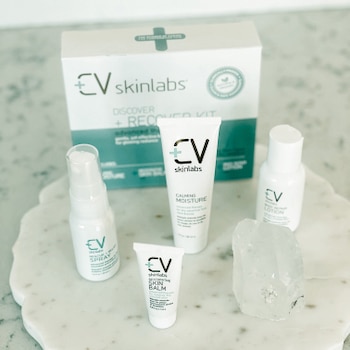
Aging and sugar are connected, they say.
So you should cut back on sugar.
But is this true? Does your skin care how many sugary sodas you drink today?
Aging and Sugar: The Basic Problem
If you have a sweet tooth, you don’t want to hear it. Surely sugar can’t have that big of an impact on your skin!
Unfortunately, we have some bad news for you: Scientists have long known that sugar can have a significant negative effect on the skin.
Glucose and fructose—the most common forms of sugar that we consume in our diet—link the amino acids present in the collagen and elastin in skin. And that’s bad.
Collagen is a naturally occurring protein in the skin that cements everything together. It builds connective and supportive tissues in the body, including the skin. Around 70 percent of the skin is composed of collagen, with elastin making up a smaller part.
Elastin is another protein that gives cells their structure. It allows your skin to stretch, contract, and resume its shape. It gives your skin the ability to “bounce back.”
Collagen and elastin proteins together create fibers that form the matrix of skin. Imagine a tennis net. Collagen is responsible for the tensile strength of the strands in the net, whereas elastin makes them elastic—gives them their spring.
In young skin, collagen and elastin fibers (or strands) are numerous, evenly produced, and symmetrical. In older skin, however, the fibers become broken, frayed, and scarce. That’s what causes the skin to sag and develop fine lines and wrinkles.
 Aging and Sugar: High Levels of Circulating Sugar Destroy Fibers in the Skin
Aging and Sugar: High Levels of Circulating Sugar Destroy Fibers in the Skin
What we want to do, then, as we age, is to protect our collagen and elastin. Protecting skin from the sun is one way to do that, as ultraviolet rays are very destructive to these fibers.
Higher levels of circulating sugars in the bloodstream, however, are damaging too. In a 2010 study, researchers noted that sugars cross-link collagen fibers, rendering them incapable of easily repairing themselves.
Imagine someone twisting up all the strands in the tennis net so it no longer spreads evenly across the court.
“Glucose and fructose link the amino acids present in the collagen and elastin that support the dermis,” the researchers write, “producing advanced glycation end products or ‘AGEs.’”
The dermis is the middle layer of the skin, just under the outer layer or epidermis. This is the layer that provides the strength and support that keeps your skin looking youthful. As it breaks down—due to damaged collagen and elastin fibers—it starts to sag, wrinkle, and look older.
The researchers went on to note that this process of sugar cross-linking the collagen and elastin fibers and producing AGEs “is accelerated in all body tissues when sugar is elevated….”
In a 2015 study, researchers compared people with high levels of circulating glucose in their bloodstream with those who had lower levels of circulating glucose. They found that those with higher levels had more skin wrinkling and were perceived as older than those with lower glucose levels.
Exposure to the sun makes the situation worse, as ultraviolet (UV) rays stimulate AGEs to produce free radicals, further damaging collagen and elastin fibers.
Aging and Sugar: What are AGEs?
So what are these AGEs anyway?
They form naturally inside the body when proteins or fats combine with sugars—a process called glycation. This affects the normal function of cells, making them more susceptible to damage and premature aging.
AGEs can also form in foods. Those that have been exposed to high temperatures—such as during grilling or frying—are typically higher in AGEs than other foods. Sugary foods and highly processed and prepackaged foods are also high in AGEs.
The body knows how to rid itself of harmful AGE compounds, but if you have too many—such as when you eat too many sugary foods—it may become overwhelmed and not be able to manage all of them.
Increased accumulation of AGEs in human tissue has been associated with kidney, cardiovascular, lung, liver, and Alzheimer’s disease—and skin aging.
In a 2015 study, researchers found that AGEs impaired wound healing and distorted blood vessels in the skin, while other studies have shown that they degrade the skin’s matrix, and encourage the formation of damaging free radicals when skin is exposed to the sun.
The accumulation of AGEs also makes collagen and elastin fibers stiff, dry, and brittle, sapping their strength and spring and making skin look dull and saggy. The structure of your skin starts to break down, while free radicals make your skin more vulnerable to environmental assaults like pollution and blue light.
Aging and Sugar: In Comes the Inflammation
Excess sugar in the diet is also connected to another thing that damages the skin: inflammation.
Fine lines and wrinkles, rashes, redness, acne, and other skin conditions are all linked with inflammation. Reducing inflammation can help these skin conditions improve.
People with diets high in refined sugar, however, may be increasing their risk of chronic inflammation, which is linked with premature aging. A 2018 review, for instance, reported that people with diets higher in sugar had more inflammatory markers in their blood.
An earlier study showed that those who reduced their intake of sugar-sweetened beverages had lower inflammation factors in their blood.
 Signs You May Be Struggling with Sugar’s Effects on Your Skin
Signs You May Be Struggling with Sugar’s Effects on Your Skin
You may think that you’re too young to worry about sugar, AGEs, inflammation, and skin damage, but think again.
According to a study published in the British Journal of Dermatology, glycation of the dermis generally starts around the age of 35, then “increases rapidly” as we age.
Some signs that your skin may be struggling with this type of damage include:
- Discoloration and hyperpigmentation
- The skin around the jowl area is sagging
- Fine lines and wrinkles forming
- The surface of the skin looks hard and dull
- Wrinkles form around the laugh lines and along the upper lip
How to Avoid Sugar’s Effects on Your Skin
To protect your skin from these and other damaging effects of excess sugar and AGEs, try these tips:
Cut back on your sugar intake.
Several studies have suggested that skin aging is connected to what foods and beverages you consume. Read food labels—many unsuspecting foods contain hidden sugars. And above all, limit sugar-sweetened soft drinks. They typically contain high fructose corn syrup, which produces more AGEs than other types of sugar.
Eat a healthy diet.
Remember that certain foods—particularly fried and grilled red meat and processed foods—can also be high in AGEs. A diet with a higher intake of vegetables and fruits, legumes, olive oil, and other healthy items has been linked to younger-looking skin, whereas a diet high in butter and margarine, dairy products, and sugar products produces more wrinkling.
Cut back on high glycemic foods.
Foods that quickly break down into glucose in the body rank high on the glycemic index. These foods are also more likely to produce AGEs in the skin, so it’s best to eat them in moderation. These include white bread, pastries, fruit juices, and desserts.
Drink more water.
It helps flush toxins out of your body, moisturizes your skin from the inside out, and helps keep you satisfied so you’re less likely to snack on sugary treats.
Modify your cooking methods.
High temperatures result in higher levels of AGEs, with dry heat promoting AGE formation by more than 10- to 100-fold above uncooked foods in all categories. Foods cooked with moist heat, shorter cooking times, and lower temperatures produce the least amount of AGEs.
Use a marinade when you grill.
Adding a marinade that contains lemon or other citrus fruit juices, or vinegar, can help reduce AGE levels in meats while enhancing the flavor.
Get enough sleep.
Your skin does most of its repair while you’re sleeping. A lack of sleep can lead to more fine lines and wrinkles.
Adopt a nourishing skincare routine.
Regularly taking care of your skin with safe products (like those from CV Skinlabs) helps counteract damage from AGEs, giving your skin the ingredients it needs to look its best.
Have you known about the link between aging and sugar?
Photo by Karolina Grabowska from Pexels.

